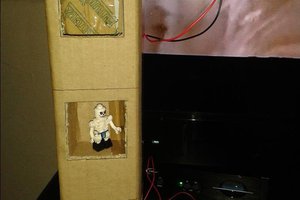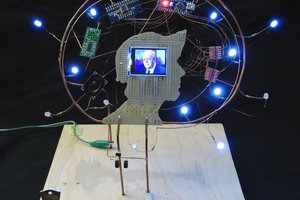Intro
This project was inspired by Joshua Klein's Crow Box, a self-described "experimentation platform designed to autonomously train corvids." However, as various biologists/corvid researchers pointed out, this project's lack of results while working with wild birds was due in large part to the fact that crows, in all their intelligence, couldn't be bothered to expend energy solving puzzles in order to get small payouts of food when they could just as well hunt around elsewhere for their usual sources of calories that were both easily accessible and plentiful. To its credit, the Crow Box was proven to be successful with captive birds as food options were inherently restricted. Because I don't have pet corvids, which require specialized licenses to keep and in all honesty don't make great pets (Peter Caine succinctly explains why here and here [heads-up: strong language]), I decided to build a similar project for training my cat and learning more about cat intelligence.
After doing research on similar efforts as well as cat intelligence I learned several things that further motivated this specific project:
First of all, not a whole lot of research has been done about domestic cats in general. Relative to the amount of experiments/studies done on dogs there are a lot fewer papers that I could draw on when designing learning progressions for the domestic cat. As any cat owner reading this may have already guessed, this seems to be due, in part, to the fact that as experiment participants cats can be hard to work with and tend to "drop out" of studies. Unlike dogs who can enthusiastically drill a target behavior during training over and over, cats do better when trained consistently for much shorter intervals where cues are extra clear, they are set up for success from the start, and smaller steps in complexity are taken as their behavior is shaped toward the target.
Second of all, the historic domestication of cats came about much more passively (and recently) than it did for dogs. While dogs were quite early on bred for specific roles: hunting, searching, herding with a specific focus on intelligence, etc., cats were valued initially for behaviors similar to those that they had while wild (e.g. by "just doing their thing" cats were killing mice and protecting grain stores for example). Additionally, even when the breeding of cats became more rigorous and intentional it was, and still is, all but completely focused on appearance and general domesticity alone. Because of this, cat intelligence hasn't been as carefully documented or selected for. We really don't have a good understanding of the cognitive limits and abilities of cats at the species level, let alone across breeds and individuals.
Lastly, I came across a propriety product that markets itself as a game console designed to stimulate pets mentally as well as teach them to solve challenges (CleverPet) that was exactly what I was looking for. Unfortunately, it is somewhat cost prohibitive for many including myself. For a much, much, smaller cost I think any tinkerer can build something similarly effective, especially if it's developed openly and allows for each and every parameter to be optimally tweaked and fine-tuned to the needs and abilities of an individual pet.
Arduino Cat Console Prototype: The Cat Box
The console is still being actively developed but so far it's basic functionality is as follows:
Once powered up, a start screen is displayed until the input button is pressed. Pressing the button additional times will cycle through the available stages and repeatedly start a short timer (visualized with a loading bar) until timeout confirms your selection. A short delay occurs before symbols are shown on the LED matrix. The initial delay, symbols to be displayed, max duration a symbol is shown, the fixed or randomly varied wait time between symbols, which symbol is rewarded, etc. are currently set to defaults but should...
Read more » Conner Sugai
Conner Sugai





 DigiGram
DigiGram
 James Kingsbery
James Kingsbery
 Chris B
Chris B
 Daniel Domínguez
Daniel Domínguez
Interesting project!
If that's OK I'd like to share a though from the point of view of a cognitive-science aware layman:
By using "symbols" you're actually targeting a concept of symbol oriented human inductive/deductive reasoning in mind. The kind of visuals-symbol mapping that you're testing may or may not exist in felines. In the negative case this would render any measurement of "intelligence" invalid. Maybe you should think of affordances with a better fit to feline agency (patterns/time series of sound, vibration and, lastly, visuals). From "symbols" that may arise there (inductive reasoning) some kind of problem solving behavior (learning) should be measurable. Then we might start discussing if we observing learned stimulus-response or even a higher level of intelligence (as we may observe in crows, e.g. tool use, tool selection, or even tool creation).